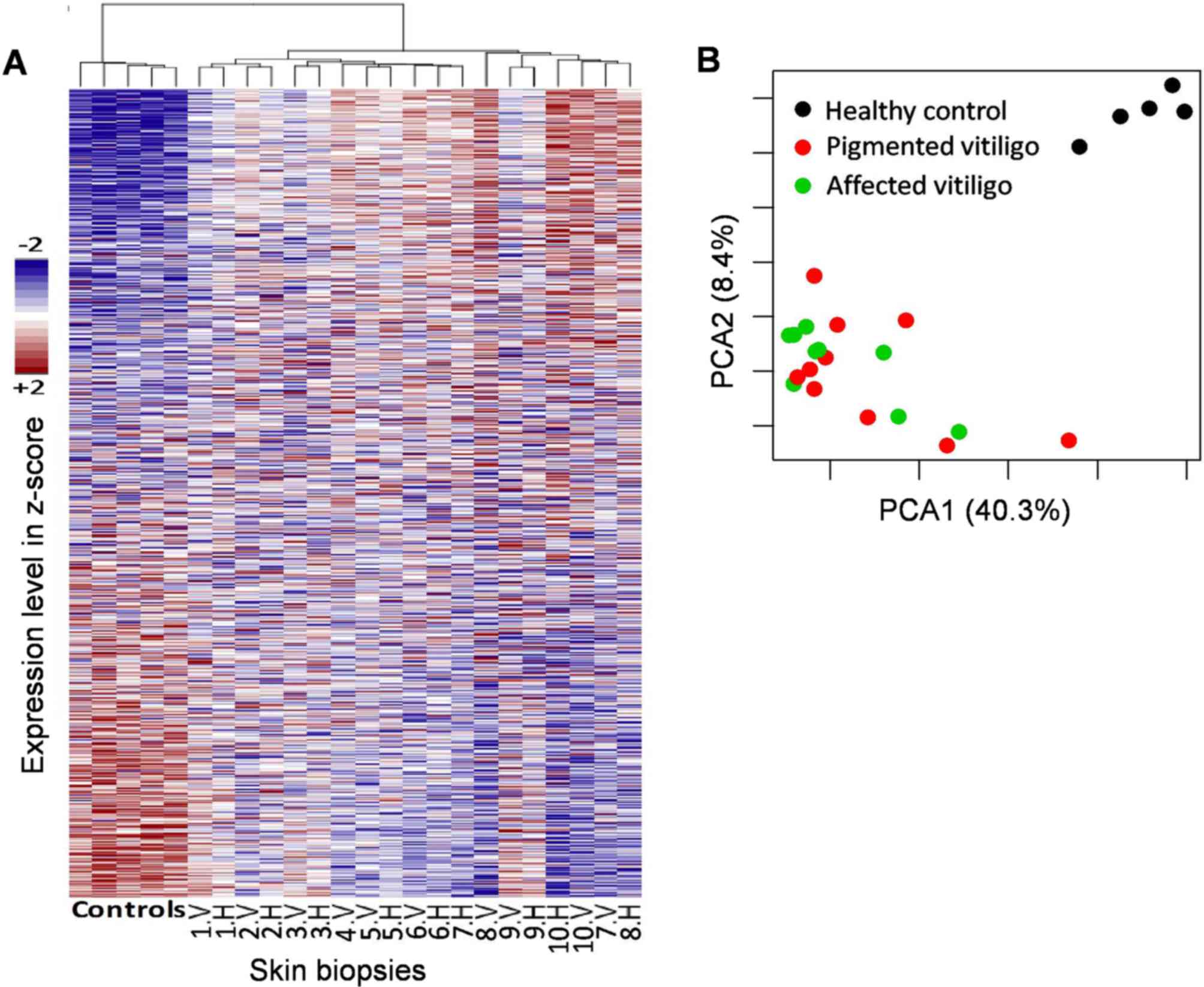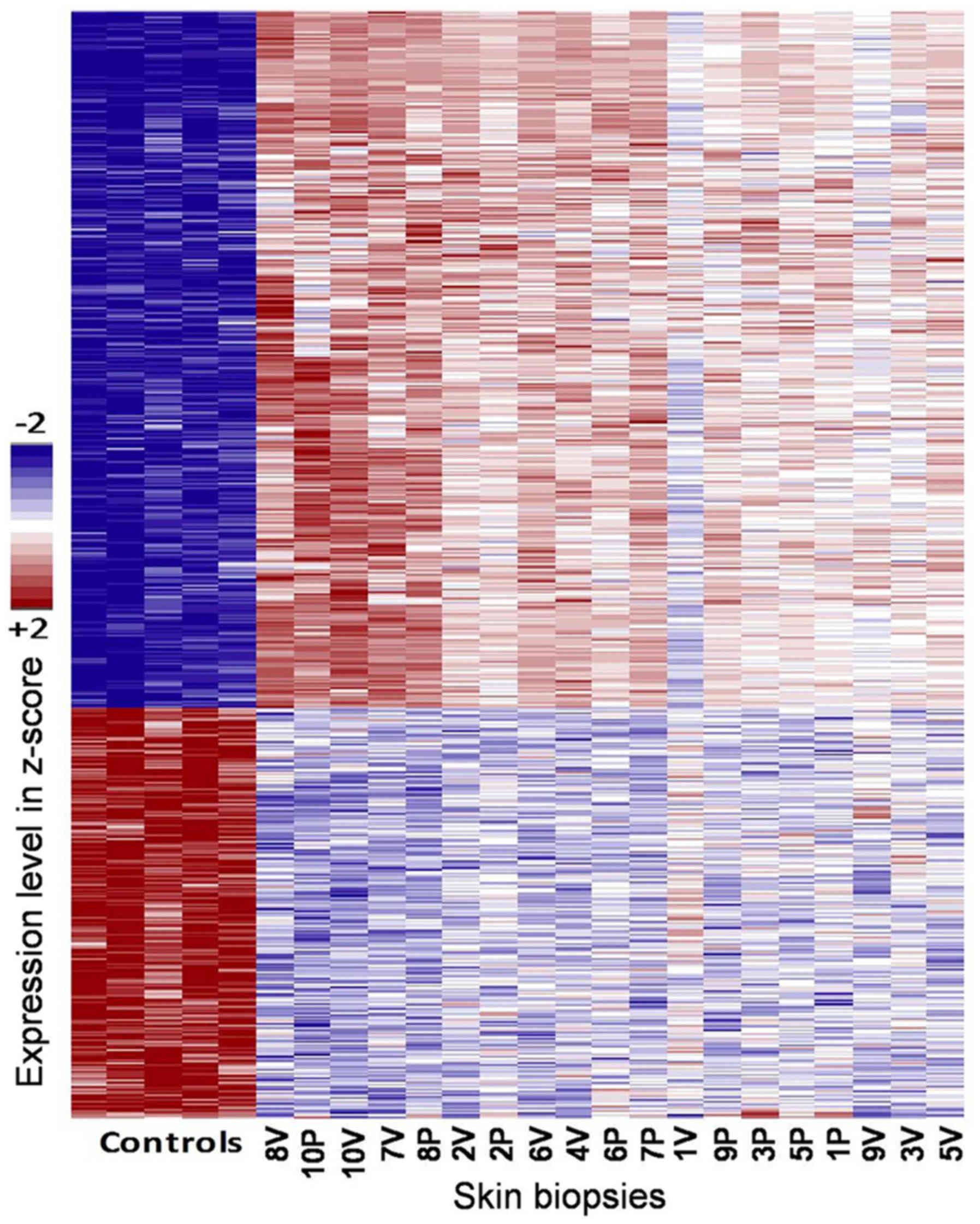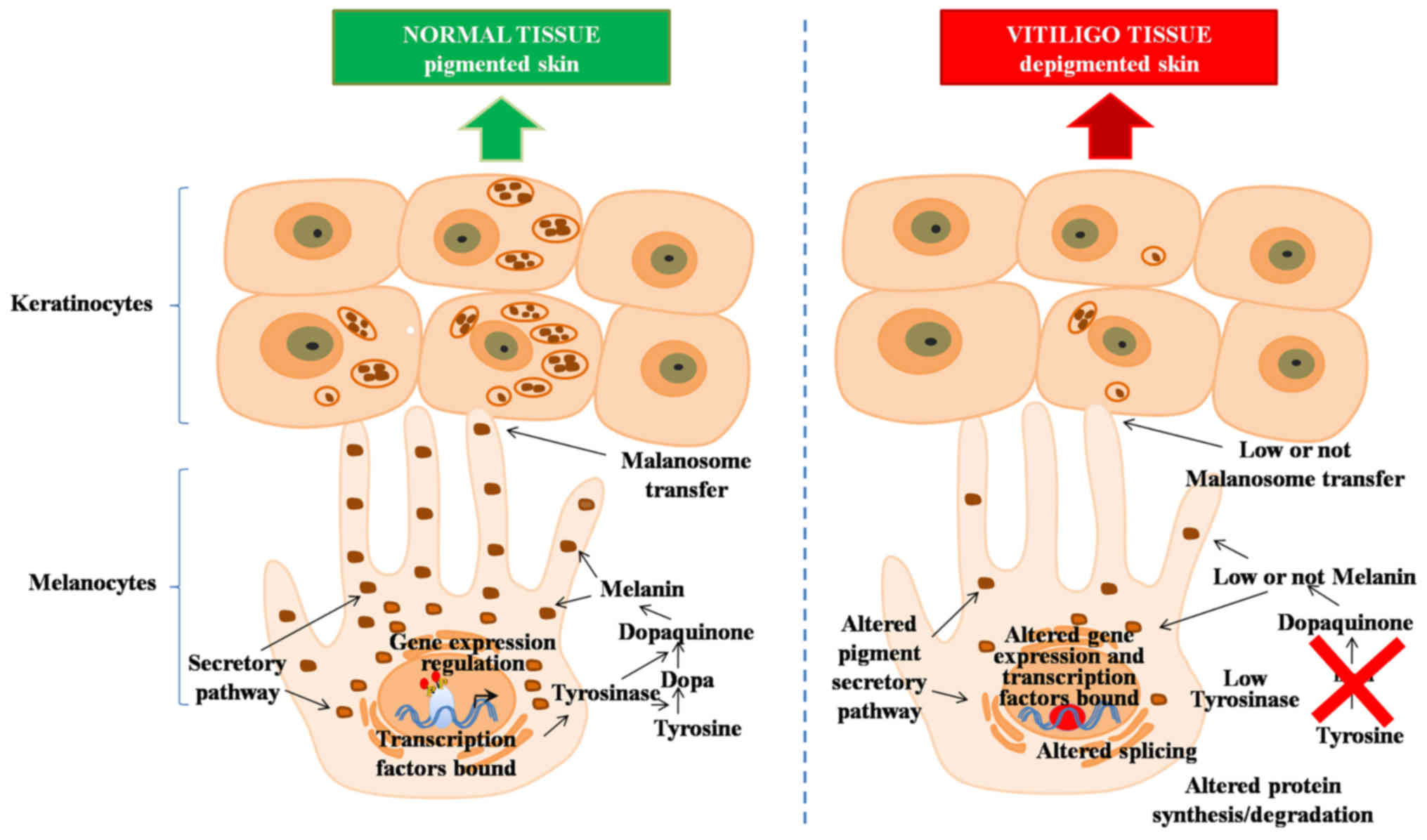|
1
|
Steiner D, Bedin V, Moraes MB, Tadeu R and
Steiner VT: Vitiligo. An Bras Dermatol. 79:335–351. 2004.
View Article : Google Scholar
|
|
2
|
Parsad D, Dogra S and Kanwar AJ: Quality
of life in patients with vitiligo. Health Qual Life Outcomes.
1:582003. View Article : Google Scholar : PubMed/NCBI
|
|
3
|
Ezzedine K, Lim HW, Suzuki T, Katayama I,
Hamzavi I, Lan CC, Goh BK, Anbar T, Silva de Castro C, Lee AY, et
al: Revised classification/nomenclature of vitiligo and related
issues: The vitiligo global issues consensus conference. Pigment
Cell Melanoma Res. 25:E1–E13. 2012. View Article : Google Scholar : PubMed/NCBI
|
|
4
|
Sehgal VN and Srivastava G: Vitiligo:
Compendium of clinico-epidemiological features. Indian J Dermatol
Venereol Leprol. 73:149–156. 2007. View Article : Google Scholar : PubMed/NCBI
|
|
5
|
Spritz RA: The genetics of generalized
vitiligo and associated autoimmune diseases. J Dermatol Sci.
41:3–10. 2006. View Article : Google Scholar : PubMed/NCBI
|
|
6
|
Spritz RA: The genetics of generalized
vitiligo and associated autoimmune diseases. Pigment Cell Res.
20:271–278. 2007. View Article : Google Scholar : PubMed/NCBI
|
|
7
|
Tazi-Ahnini R, McDonagh AJ, Wengraf DA,
Lovewell TR, Vasilopoulos Y, Messenger AG, Cork MJ and Gawkrodger
DJ: The autoimmune regulator gene (AIRE) is strongly associated
with vitiligo. Br J Dermatol. 159:591–596. 2008.PubMed/NCBI
|
|
8
|
Mohammed GF, Gomaa AH and Al-Dhubaibi MS:
Highlights in pathogenesis of vitiligo. World J Clin Cases.
3:221–230. 2015. View Article : Google Scholar : PubMed/NCBI
|
|
9
|
McCurdy HM: Enzyme localization during
melanogenesis. J Cell Biol. 43:220–228. 1969. View Article : Google Scholar : PubMed/NCBI
|
|
10
|
Lee AY: Role of keratinocytes in the
development of vitiligo. Ann Dermatol. 24:115–125. 2012. View Article : Google Scholar : PubMed/NCBI
|
|
11
|
Slominski A, Ermak G and Wortsman J:
Modification of melanogenesis in cultured human melanoma cells. In
Vitro Cell Dev Biol Anim. 35:564–565. 1999. View Article : Google Scholar : PubMed/NCBI
|
|
12
|
Gillbro JM, Marles LK, Hibberts NA and
Schallreuter KU: Autocrine catecholamine biosynthesis and the
beta-adrenoceptor signal promote pigmentation in human epidermal
melanocytes. J Invest Dermatol. 123:346–353. 2004. View Article : Google Scholar : PubMed/NCBI
|
|
13
|
Rousseau K, Kauser S, Pritchard LE,
Warhurst A, Oliver RL, Slominski A, Wei ET, Thody AJ, Tobin DJ and
White A: Proopiomelanocortin (POMC), the ACTH/melanocortin
precursor, is secreted by human epidermal keratinocytes and
melanocytes and stimulates melanogenesis. FASEB J. 21:1844–1856.
2007. View Article : Google Scholar : PubMed/NCBI
|
|
14
|
Kingo K, Aunin E, Karelson M, Philips MA,
Rätsep R, Silm H, Vasar E, Soomets U and Kõks S: Gene expression
analysis of melanocortin system in vitiligo. J Dermatol Sci.
48:113–122. 2007. View Article : Google Scholar : PubMed/NCBI
|
|
15
|
Kingo K, Aunin E, Karelson M, Rätsep R,
Silm H, Vasar E and Kõks S: Expressional changes in the
intracellular melanogenesis pathways and their possible role in the
pathogenesis of vitiligo. J Dermatol Sci. 52:39–46. 2008.
View Article : Google Scholar : PubMed/NCBI
|
|
16
|
Nagui NA, Mahmoud SB, Abdel Hay RM,
Hassieb MM and Rashed LA: Assessment of gene expression levels of
proopiomelanocortin (POMC) and melanocortin-1 receptor (MC1R) in
vitiligo. Australas J Dermatol. 58:e36–e39. 2017. View Article : Google Scholar : PubMed/NCBI
|
|
17
|
Stromberg S, Bjorklund MG, Asplund A,
Rimini R, Lundeberg J, Nilsson P, Pontén F and Olsson MJ:
Transcriptional profiling of melanocytes from patients with
vitiligo vulgaris. Pigment Cell Melanoma Res. 21:162–171. 2008.
View Article : Google Scholar : PubMed/NCBI
|
|
18
|
Irizarry RA, Hobbs B, Collin F,
Beazer-Barclay YD, Antonellis KJ, Scherf U and Speed TP:
Exploration, normalization and summaries of high density
oligonucleotide array probe level data. Biostatistics. 4:249–264.
2003. View Article : Google Scholar : PubMed/NCBI
|
|
19
|
Benjamini Y and Hochberg Y: Controlling
the false discovery rate: A practical and powerful approach to
multiple testing. J Royal Stat Soc. 57:289–300. 1995.
|
|
20
|
Huang da W, Sherman BT and Lempicki RA:
Systematic and integrative analysis of large gene lists using DAVID
bioinformatics resources. Nat Protoc. 4:44–57. 2009. View Article : Google Scholar : PubMed/NCBI
|
|
21
|
Huang da W, Sherman BT and Lempicki RA:
Bioinformatics enrichment tools: Paths toward the comprehensive
functional analysis of large gene lists. Nucleic Acids Res.
37:1–13. 2009. View Article : Google Scholar : PubMed/NCBI
|
|
22
|
Shi F, Kong BW, Song JJ, Lee JY,
Dienglewicz RL and Erf GF: Understanding mechanisms of vitiligo
development in Smyth line of chickens by transcriptomic microarray
analysis of evolving autoimmune lesions. BMC Immunol. 13:182012.
View Article : Google Scholar : PubMed/NCBI
|
|
23
|
Jimbow K, Quevedo WC Jr, Fitzpatrick TB
and Szabo G: Some aspects of melanin biology: 1950–1975. J Invest
Dermatol. 67:72–89. 1976. View Article : Google Scholar : PubMed/NCBI
|
|
24
|
Feinmesser M, Tsabari C, Fichman S, Hodak
E, Sulkes J and Okon E: Differential expression of proliferation-
and apoptosis-related markers in lentigo maligna and solar
keratosis keratinocytes. Am J Dermatopathol. 25:300–307. 2003.
View Article : Google Scholar : PubMed/NCBI
|
|
25
|
Baroni A, Buommino E, De Gregorio V,
Ruocco E, Ruocco V and Wolf R: Structure and function of the
epidermis related to barrier properties. Clin Dermatol. 30:257–262.
2012. View Article : Google Scholar : PubMed/NCBI
|
|
26
|
Yoshida Y, Hachiya A, Sriwiriyanont P,
Ohuchi A, Kitahara T, Takema Y, Visscher MO and Boissy RE:
Functional analysis of keratinocytes in skin color using a human
skin substitute model composed of cells derived from different skin
pigmentation types. FASEB J. 21:2829–2839. 2007. View Article : Google Scholar : PubMed/NCBI
|
|
27
|
Moretti S, Fabbri P, Baroni G, Berti S,
Bani D, Berti E, Nassini R, Lotti T and Massi D: Keratinocyte
dysfunction in vitiligo epidermis: Cytokine microenvironment and
correlation to keratinocyte apoptosis. Histol Histopathol.
24:849–857. 2009.PubMed/NCBI
|
|
28
|
Regazzetti C, Joly F, Marty C, Rivier M,
Mehul B, Reiniche P, Mounier C, Rival Y, Piwnica D, Cavalié M, et
al: Transcriptional analysis of vitiligo skin reveals the
alteration of wnt pathway: A promising target for repigmenting
vitiligo patients. J Invest Dermatol. 135:3105–3114. 2015.
View Article : Google Scholar : PubMed/NCBI
|
|
29
|
Moretti D, Del Bello B, Cosci E, Biagioli
M, Miracco C and Maellaro E: Novel variants of muscle calpain 3
identified in human melanoma cells: Cisplatin-induced changes in
vitro and differential expression in melanocytic lesions.
Carcinogenesis. 30:960–967. 2009. View Article : Google Scholar : PubMed/NCBI
|
|
30
|
Hoek KS, Schlegel NC, Eichhoff OM, Widmer
DS, Praetorius C, Einarsson SO, Valgeirsdottir S, Bergsteinsdottir
K, Schepsky A, Dummer R and Steingrimsson E: Novel MITF targets
identified using a two-step DNA microarray strategy. Pigment Cell
Melanoma Res. 21:665–676. 2008. View Article : Google Scholar : PubMed/NCBI
|
|
31
|
Guindalini C, Lee KS, Andersen ML,
Santos-Silva R, Bittencourt LR and Tufik S: The influence of
obstructive sleep apnea on the expression of glycerol-3-phosphate
dehydrogenase 1 gene. Exp Biol Med (Maywood). 235:52–56. 2010.
View Article : Google Scholar : PubMed/NCBI
|
|
32
|
Hubmann G, Guillouet S and Nevoigt E: Gpd1
and Gpd2 fine-tuning for sustainable reduction of glycerol
formation in Saccharomyces cerevisiae. Appl Environ Microbiol.
77:5857–5867. 2011. View Article : Google Scholar : PubMed/NCBI
|
|
33
|
Finotello F and Di Camillo B: Measuring
differential gene expression with RNA-seq: Challenges and
strategies for data analysis. Brief Funct Genomics. 14:130–142.
2015. View Article : Google Scholar : PubMed/NCBI
|
|
34
|
Hurd PJ and Nelson CJ: Advantages of
next-generation sequencing versus the microarray in epigenetic
research. Brief Funct Genomic Proteomic. 8:174–183. 2009.
View Article : Google Scholar : PubMed/NCBI
|
|
35
|
Git A, Dvinge H, Salmon-Divon M, Osborne
M, Kutter C, Hadfield J, Bertone P and Caldas C: Systematic
comparison of microarray profiling, real-time PCR and
next-generation sequencing technologies for measuring differential
microRNA expression. RNA. 16:991–1006. 2010. View Article : Google Scholar : PubMed/NCBI
|
|
36
|
Kloster MB, Bilgrau AE, Rodrigo-Domingo M,
Bergkvist KS, Schmitz A, Sønderkær M, Bødker JS, Falgreen S,
Nyegaard M, Johnsen HE, et al: A model system for assessing and
comparing the ability of exon microarray and tag sequencing to
detect genes specific for malignant B-cells. BMC Genomics.
13:5962012. View Article : Google Scholar : PubMed/NCBI
|
|
37
|
Mastrokolias A, den Dunnen JT, van Ommen
GB, 't Hoen PA and van Roon-Mom WM: Increased sensitivity of next
generation sequencing-based expression profiling after globin
reduction in human blood RNA. BMC Genomics. 13:282012. View Article : Google Scholar : PubMed/NCBI
|
|
38
|
Gonorazky H, Liang M, Cummings B, Lek M,
Micallef J, Hawkins C, Basran R, Cohn R, Wilson MD, MacArthur D,
Marshall CR, et al: RNAseq analysis for the diagnosis of muscular
dystrophy. Ann Clin Transl Neurol. 3:55–60. 2015. View Article : Google Scholar : PubMed/NCBI
|
|
39
|
Lesluyes T, Pérot G, Largeau MR, Brulard
C, Lagarde P, Dapremont V, Lucchesi C, Neuville A, Terrier P,
Vince-Ranchère D, et al: RNA sequencing validation of the
Complexity INdex in SARComas prognostic signature. Eur J Cancer.
57:104–111. 2016. View Article : Google Scholar : PubMed/NCBI
|
|
40
|
Chandrasekharappa SC, Lach FP, Kimble DC,
Kamat A, Teer JK, Donovan FX, Flynn E, Sen SK, Thongthip S, Sanborn
E, et al: Massively parallel sequencing, aCGH and RNA-Seq
technologies provide a comprehensive molecular diagnosis of Fanconi
anemia. Blood. 121:e138–e148. 2013. View Article : Google Scholar : PubMed/NCBI
|
|
41
|
O'Hurley G, Busch C, Fagerberg L,
Hallström BM, Stadler C, Tolf A, Lundberg E, Schwenk JM, Jirström
K, Bjartell A, et al: Analysis of the human prostate-specific
proteome defined by transcriptomics and antibody-based profiling
identifies TMEM79 and ACOXL as two putative, diagnostic markers in
prostate cancer. PLoS One. 10:e01334492015. View Article : Google Scholar : PubMed/NCBI
|
|
42
|
Endsley MP, Moyle-Heyrman G, Karthikeyan
S, Lantvit DD, Davis DA, Wei JJ and Burdette JE: Spontaneous
transformation of murine oviductal epithelial cells: A model system
to investigate the onset of fallopian-derived tumors. Front Oncol.
5:1542015. View Article : Google Scholar : PubMed/NCBI
|
|
43
|
Katayama S, Skoog T, Jouhilahti EM,
Siitonen HA, Nuutila K, Tervaniemi MH, Vuola J, Johnsson A,
Lönnerberg P, Linnarsson S, et al: Gene expression analysis of skin
grafts and cultured keratinocytes using synthetic RNA normalization
reveals insights into differentiation and growth control. BMC
Genomics. 16:4762015. View Article : Google Scholar : PubMed/NCBI
|
|
44
|
Wang Z, Gerstein M and Snyder M: RNA-Seq:
A revolutionary tool for transcriptomics. Nat Rev Genet. 10:57–63.
2009. View Article : Google Scholar : PubMed/NCBI
|
|
45
|
Swindell WR, Remmer HA, Sarkar MK, Xing X,
Barnes DH, Wolterink L, Voorhees JJ, Nair RP, Johnston A, Elder JT
and Gudjonsson JE: Proteogenomic analysis of psoriasis reveals
discordant and concordant changes in mRNA and protein abundance.
Genome Med. 7:862015. View Article : Google Scholar : PubMed/NCBI
|
|
46
|
Stone RC, Du P, Feng D, Dhawan K, Rönnblom
L, Eloranta ML, Donnelly R and Barnes BJ: RNA-Seq for enrichment
and analysis of IRF5 transcript expression in SLE. PLoS One.
8:e544872013. View Article : Google Scholar : PubMed/NCBI
|
|
47
|
Shi L, Zhang Z, Yu AM, Wang W, Wei Z,
Akhter E, Maurer K, Costa Reis P, Song L, Petri M and Sullivan KE:
The SLE transcriptome exhibits evidence of chronic endotoxin
exposure and has widespread dysregulation of non-coding and coding
RNAs. PLoS One. 9:e938462014. View Article : Google Scholar : PubMed/NCBI
|














